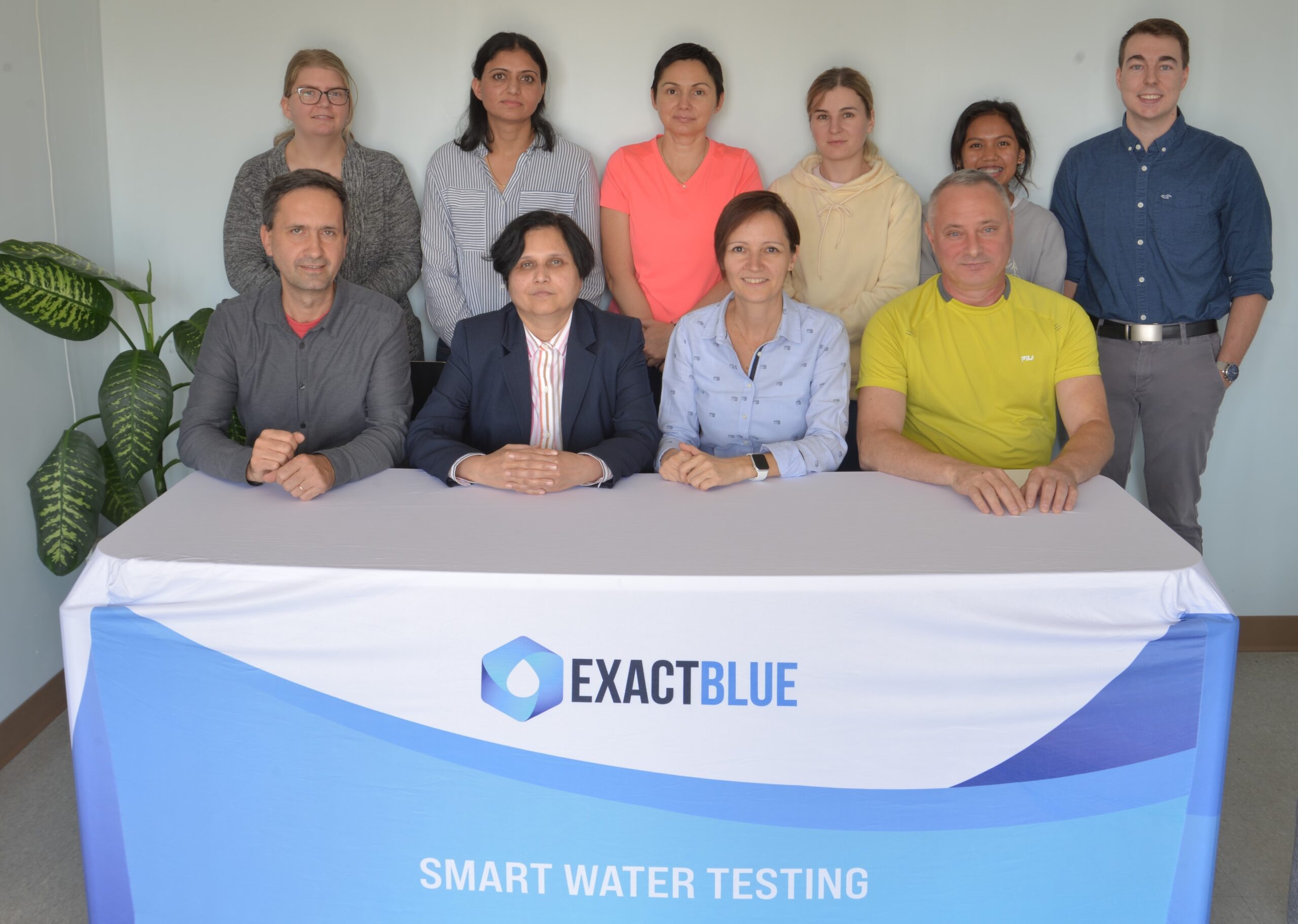With support from the Ontario Water Consortium’s Water Industry Growth Program, ExactBlue Technologies is validating their mobile quantitative-testing platform for Rapid E coli and Coliform.
Water-borne microbes can cause a host of problems, from temporary tummy trouble to far more serious conditions. That’s why regular water tests are crucial in all kinds of settings. But sending samples to a commercial lab is costly, and results can take more than a week to arrive.
ExactBlue Technologies aims to change that. Their affordable, nano-powered solution allows businesses and consumers to test their water on the spot.
When husband-and-wife team Ela and George Botos launched the Cambridge-based company in 2015, they began by focussing on dental offices, where contaminated waterlines can lead to serious infections. Their Aquavial Quick Check kits make it easy to determine if dangerous bacteria, fungi or biofilms are present: just add water to a tube, shake it and see whether the colour changes.
Results are visible within 30 minutes. And because the testing is done on site, there’s no opportunities for microbes in the sample to either multiply or die on the way to a lab, ensuring highly accurate results.
The secret lies in gold nanoparticles that attach to the cell membranes of bacteria and other microorganisms, triggering a measurable colour change in water samples. By customizing the shape and charge of the nanoparticles, ExactBlue can design them to detect a wide range of contaminants.
For customers that need a more sophisticated analysis, ExactBlue also offers a mobile testing platform that can quantify various contaminant levels and deliver detailed reports to your smartphone.
Today, the company is the leading microbial detection supplier for dentists in Canada and is making inroads into the U.S. market. They’ve also expanded into other industries, as well as offering at-home testing kits for consumers. As a result, ExactBlue has grown to 17 employees and — aside from some COVID hiccups — doubled their revenues year after year.
But they know the potential uses for their innovation are much broader. “It’s a platform technology,” explains Ela, the company’s CEO. “We started targeting specific microbial contamination like E. coli, Pseudomonas, Legionella, and we continue to add tests to this technology.”
That opens the door to a slew of applications.
Targeting new markets
Consider companies that wash and package leafy greens. Regularly testing the wash water is crucial to ensure the vegetables aren’t contaminated with E. coli or other microbes. But current lab testing takes days, leaving the greens to sit in the processing facility until the results arrive.
With ExactBlue’s technology, they could test the water at the beginning of a shift and have the results eight hours later. That means the produce reaches retailers — and dinner plates — much faster.
In drinking water treatment plants, on-the-spot testing would allow employees to detect and address potential issues as quickly as possible. Faster test results mean they’ll also be able to lift boil water advisories sooner once the problem is fixed.
Then there are public beaches, where E. coli tests determine whether it’s safe to swim. “We could do testing early morning, and by 10 o’clock when people are going to the beach you could have results,” says George, ExactBlue’s Chief Operations Officer.
Building credibility and consumer confidence
To gain traction in these new markets, ExactBlue is working to obtain approvals from two key bodies.
Certification from NSF — the global standard in public health and safety — will allow ExactBlue to offer their technology to North American water utilities. Meanwhile, the greenlight from the Association of Official Analytical Chemists (AOAC) is key to breaking into sectors like agriculture, food processing and environmental monitoring.
“Validation would give us more marketing power,” says Ela. At the same time, she adds, it will move them one step closer to crucial approvals from the Canadian Food Inspection Agency and the U.S. Environmental Protection Agency.
For support on the road to certification, Ela and George turned to OWC’s Water Industry Growth (WIG) program, which helps water tech companies bring their solutions to market. WIG funding allowed them to develop an updated version of their mobile quantitative-testing platform, as well as a new and improved app and cloud-based software.
By mid-October, they’ll be ready for the NSF certification process.
Bypassing bottlenecks
Lab-based PCR testing is the gold standard, and ExactBlue isn’t trying to replace it. But they believe rapid, affordable, point-of-use testing will allow organizations to test their water more frequently.
That’s because labs across the country are backed up. And expanding their testing capacity is no small undertaking, requiring more lab facilities, staff and supplies. At the same time, George points out that PCR testing typically costs $250 a shot. ExactBlue’s solution is significantly cheaper — and as they scale up production, the costs will drop even further.
The result is safer water for everyone, whether you’re in the dentist chair, heading to the beach, or grabbing a salad to go.
WIG supports industry innovations that accelerate growth, create jobs and strengthen Ontario’s water sector. For more information, click here.


